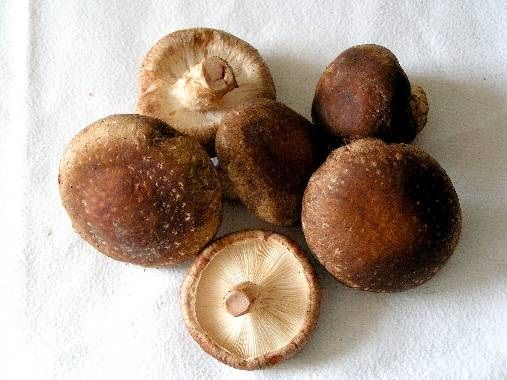Nutritional aspects of shiitake mushrooms, recipes, and their functional food properties
Find the recipe collection with different ways to cook and taste shiitake mushrooms and a clear explainer of nutritional and functional properties.

Coming from Asia (mainly Japan and China), the shiitake is currently the most cultivated mushroom in the world and is recognized as a species of pleasant taste and attractive aroma, qualities that have favored its wide commercial distribution. The sensory qualities of shiitake have allowed it to quickly become incorporated from Asian cuisine into world gastronomy. Nowadays it is frequent to find different dishes based on shiitake and it has more and more presence in the markets of America and Europe in very different forms.
The popularity of the shiitake has increased in good part by its exotic flavor, but also by its well-known nutritional and medicinal properties. Shiitake is a good source of vitamins among which the B complex stands out, mainly vitamins B1 (thiamine), B2 (riboflavin), B3 (niacin), and B12 (cobalamin), folic acid, as well as vitamins C and D. It also provides significant amounts of minerals such as calcium, phosphorus, iron, sodium, magnesium, zinc, and potassium. Shiitake contains almost all the essential amino acids for good nutrition of the human body with especially abundant amounts of alanine, arginine lysine, and leucine, while methionine, histidine, and phenylalanine are less abundant.
These mushrooms are also a good source of dietary fiber (6.7% in dry weight), which gives them important properties in the prevention of constipation, diabetes, obesity, hypertension, colon cancer, and arteriosclerosis, as well as lowering cholesterol levels. Shiitake is accepted worldwide, not only because of its excellent aroma, taste, and nutritional characteristics, but also because of its medicinal properties. These are mainly attributed to the presence of structural polysaccharides and heteropolysaccharides, as well as terpenoids, among others.
The mushroom contains vitamin C and high amounts of ergosterol, a provitamin which in the presence of sunlight is converted to vitamin D, as well as niacin, thiamine, and riboflavin. Vitamin D is necessary for the absorption of calcium and phosphorus and has positive effects on the treatment of colon cancer. Shiitake also contains protein, carbohydrates, fiber, vitamins, minerals, and lipids. The amount of protein fluctuates from 13 to 35% of the dry weight. It has between 67 and 79% carbohydrates. The fat content in the mushroom is low, 0.5-5%, which represents an advantage from the health point of view. The lipids present are oleic and linoleic acid, which make up 73-77% of the total fat.
The daily consumption of only 90 g of fresh shiitake during seven days induces the reduction of up to 12% of the cholesterol in the blood.
Currently, there is solid scientific evidence based on chemical analysis and the use of in vitro, animal, and human models. This fungus has a beneficial effect against high blood pressure, liver diseases, among others; this makes it a product of great interest in public health. Shiitake not only represents a source of nutrients for consumers, but has also been used as a medicinal tonic for over two millennia. In the last decades, many of its properties attributed by the Asian traditional medicine have been scientifically demonstrated. The bioactivities of shiitake such as antiviral, antimutagenic, antinociceptive, anti-inflammatory, cytostatic, anticancer, and immunomodulating, have been widely studied.

Shiitake mushrooms have the peculiarity of presenting a very exquisite flavor, although somewhat strong for the palates that are not used to its consumption. Especially in the dehydrated product, its sensory characteristics are increased, so it is recommended to consume them in small portions and to increase its tasting gradually, until its flavor is enjoyed to the maximum. If the mushrooms are fresh, they should be cleaned with a dry cloth to remove any foreign particles, such as residues from the growing substrate. If it is necessary to wash them, place them preferably at the tap, avoiding leaving them submerged so that they do not absorb excess water. If the mushrooms are dehydrated, they should be left to soak for 30 minutes in warm water so that they recover their natural appearance.
Marinated shiitake mushrooms recipe
Ingredients
400 g of shiitake
1 slice of ginger (just under 1 cm thick)
2 cloves of garlic
2 tablespoons of soy sauce
3 tablespoons of sesame oil
1 teaspoon rice vinegar
25 g of pine nuts
1 pinch of salt
extra virgin olive oil
freshly chopped coriander
Elaboration
The mushrooms are cleaned, removing their feet. Preferably they are processed whole, although they can also be cut in two or four portions, which will depend on the size of the mushrooms. Cook with a minimum of water (½ cup) for 10 minutes over low heat in a covered pan.
In a separate container prepare the marinade with the ginger and finely grated garlic, the soy sauce, the sesame oil, and the rice vinegar, mixing well all the ingredients. The mushrooms are incorporated and with the help of a spoon, they are impregnated well with the marinade, as much by the outer part of the hat as by the interior. This will be necessary to do it well with all the hats to enrich the flavor of the shiitake.
Finally, add the pine nuts, the coriander, and rectify the seasoning, adding salt if necessary. It is recommended to prepare the marinade a couple of hours before tasting and keep it in a fresh environment. It is served with toast or wholemeal bread.
Shiitake appetizer recipe
Ingredients
300 g of shiitake
½ medium onion
1 clove of garlic
2 tablespoons of soy sauce
5 tablespoons of olive oil
1 tablespoon of parsley
Salt and black pepper to taste, basil or thyme
Elaboration
In a saucepan heat the olive oil over medium heat and add the garlic and onion finely chopped, sautéing until transparent. Add the mushrooms and let them cook for a few minutes. Add the soy sauce, the chopped parsley, and some salt and freshly ground black pepper. Serve with chopped basil leaves or some fresh thyme on top of the mushrooms, accompanied by toast or wholemeal bread.
Rice with shiitake mushrooms recipe
Ingredients
200 g of rice
80 g of carrots
80 g of peas
30 g of butter
15 g of dehydrated shiitake
1L of water (to hydrate the shiitake mushrooms)
1 clove of garlic
Salt to taste
Elaboration
Soak the shiitake for 30 minutes in a liter of water, then remove and drain the shiitake and chop it into medium pieces, reserve the water. Soak the rice for 30 minutes in clean water, then rinse the rice to remove as much starch as possible. Peel the carrot and cut it into medium pieces.
Place the butter with the garlic in a saucepan over low heat, add the rice, and brown slightly. Add the shiitake and fry for 3 more minutes. Add the soaking water of the shiitake. When it breaks the boil, place the carrots and the peas and add salt to taste. Cook the rice over low heat to allow the water to evaporate.
Crunchy balls filled with shiitake mushrooms recipe
Ingredients
100 g of shiitake
1 zucchini
55 g Parmesan cheese
55 g of gouda cheese
3 eggs
100 g of flour
100 g of breadcrumbs
1 branch of parsley
Salt and pepper to taste
Enough oil to fry the balls
Elaboration
Rehydrate or lightly cook the mushrooms and chop finely. Grate the zucchini. Beat the eggs with the grated cheese, the chopped parsley, and season with salt and pepper. Add the zucchini to the mixture and integrate it until it becomes a paste. Form little balls of the size of a bite and pass them through the flour, take it to the refrigerator for an hour.
Remove the balls from the refrigerator and put them again in the flour, then in the egg, and finally in the breadcrumbs, repeat the process again and fry them in hot oil. Place the balls on absorbent paper to remove excess fat, make a hole, and place the shiitake in the center.
Shiitake chimichangas recipe
Ingredients
150 g of shiitake
4 flour tortillas
120 g Cheddar cheese
100 g of spinach
1 jalapeño bell pepper
½ pcs. of a medium onion
1 tablespoon of salt
Olive oil
Salt and pepper
Elaboration
Cut the onion into feathers and sauté it with olive oil until it is acitronized. On a very low heat add the sugar and stop caramelizing. Set aside. Remove the veins from the chili and cut it in julienne. Cut the shiitake in slices, sauté them lightly with the chili peppers in olive oil, season with salt and pepper.
Add at the last moment the spinach cut in long very thin strips (chiffonade) and take it out from the fire. Grate the cheese. Put in the center of the flour tortilla the shiitake preparation, the spinach, and the grated cheese. Fold the 2 opposite ends over the filling and form a roll so that it is well closed. Serve with caramelized onions.
Pasta with shiitake mushrooms recipe
Ingredients
250 g of pasta (noodles, capellini, or rice noodles)
250 g of shiitake
1 sweet bell pepper
1 small leek
1 tablespoon of safflower oil
Finely grated ginger, chopped parsley
Salt and pepper to taste
Elaboration
Clean the mushrooms and cut them into slices. Devein the bell pepper and cut it into strips. The leek is cut into thin slices. Heat the oil in a saucepan over medium heat, add the mushrooms, the bell pepper, the ginger, and the leek, and leave to cook for 5 to 10 minutes. Place the pasta in a pan of boiling water, following the cooking instructions on the package.
When the desired cooking time is reached, remove from the heat and drain the excess water. Transfer the pasta to the casserole with the rest of the ingredients, mixing them in a soft way. At the moment of serving it is sprinkled with chopped parsley.
Shiitake with baked potatoes recipe
Ingredients
500 g shiitake mushrooms
1 kg of potatoes peeled and cut into segments
1 cup parmesan cheese
1 cup of cream
3 tablespoons of butter
½ medium onion
2 cloves of garlic
1 branch of rosemary
Salt, pepper to taste
Elaboration
Clean the mushrooms and cut them into thin slices. Finely chop the onion and garlic. Heat the butter and season the onion until it is translucent. Then add the mushrooms and let them sauté until the liquid has evaporated, approximately 10 minutes. Add the chopped garlic and rosemary and cook for a few more minutes. Preheat the oven to 190 °C.
Grease a refractory mould and place 1/3 of the potatoes in the refractory. Add half of the cooked mushrooms and cover them with 1/3 of the cheese. Repeat a layer of potatoes and mushrooms and finish with a layer of potatoes. In a separate bowl mix the cream, salt, and a bit of pepper. Put the mixture on top of the layer of potatoes.
Cover with aluminum foil. Put the baking dish in the middle of the oven. Cook until the potatoes are soft, approximately 1 hour to 1 ¼. Then remove the aluminum foil cover and bake 15 minutes more. Serve hot.
Shiitake in the wine sauce recipe
Ingredients
500 g of beef cut into cubes
500 g of shiitake
750 ml of red wine
1 tablespoon of raspberry jam
1 tablespoon of safflower oil
1 tablespoon of Worcestershire sauce
Laurel, thyme, salt, and pepper to taste
Elaboration
Season the meat with salt and pepper to taste and keep it at room temperature while cleaning and slicing the mushrooms. Heat the oil in a saucepan over medium heat and add the mushrooms, frying them for 5 to 10 minutes, or until golden.
Remove the mushrooms from the saucepan and cook the meat cubes in the same container, at medium-high heat, trying to turn them over to achieve an even sealing of all sides. Remove the meat from the pan.
Use the same container to heat the red wine until it boils, then add the raspberry jam and the English sauce and let it reduce the liquid by half. Add the mushrooms, the meat, and the aromatic herbs and continue cooking at low heat for 15 minutes more.
Authors:
Mata, G., R. Gaitán-Hernández, D. Salmones, 2020. Excerpt and recipes from the book in Spanish El cultivo del shiitake: tecnología e innovación en la producción de un alimento y medicina ancestral. Source: Institute of Ecology, A.C., Xalapa, Mexico.




